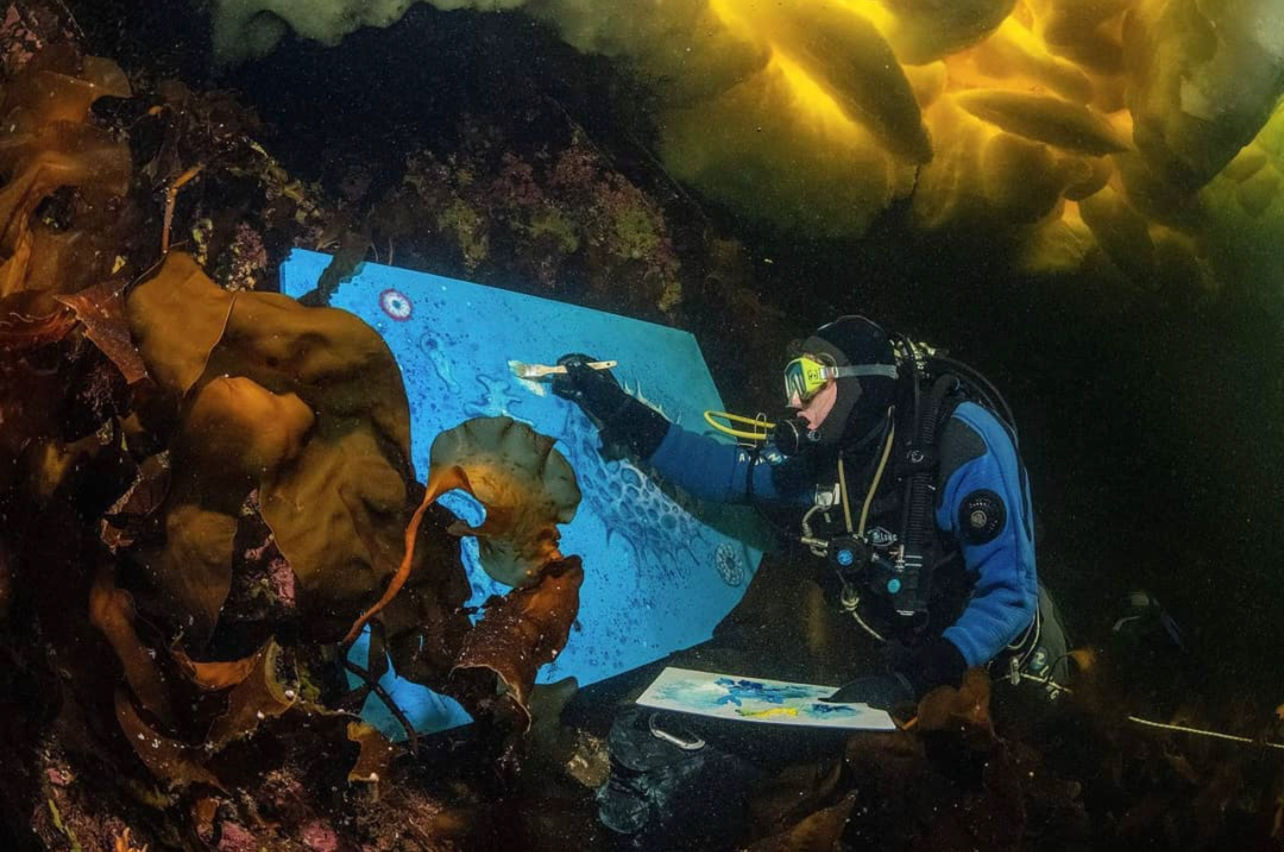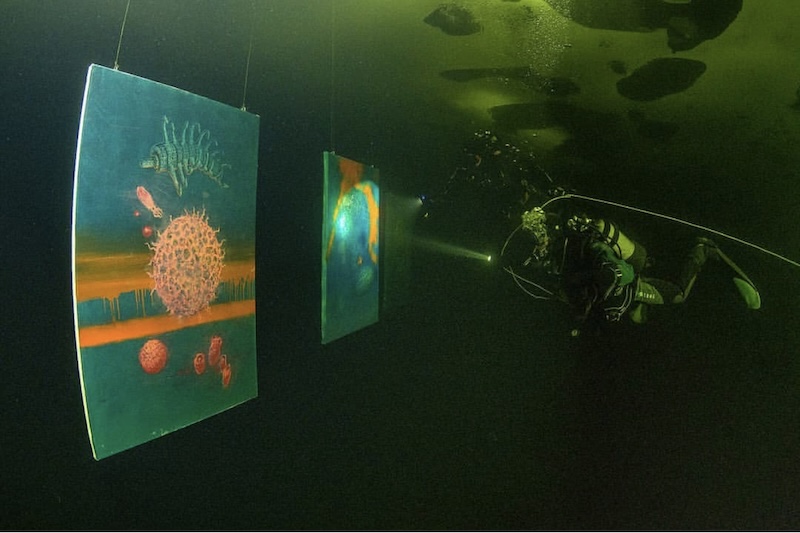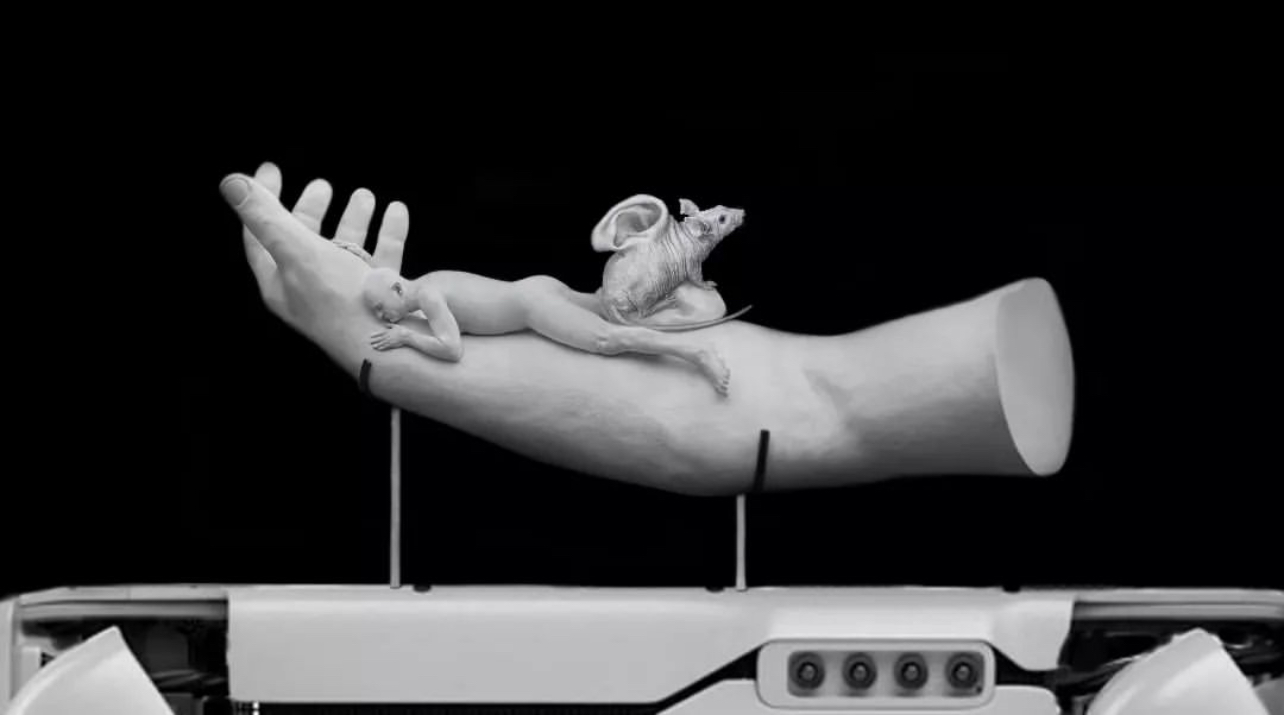
Text: Marina Alvitr
interview with Denis Lotarev — artist who had been creating his art underwater for a long period of time, is already out. Today Denis explores deep media, generative technology, digital possibilities, and also creates meta-spaces. We talked about his art path and things that matter to him the most, things that he wants to show the viewer.
How did everything start? Why did you decide to create things under the sea while everyone was involved into plein air painting being by the sea?
Yes, in fact, I started with landscapes, only created them underwater. Since childhood, I have been interested in two things: art, I went to art school very early, and the underwater world: Jacques Cousteau's Odyssey impressed me too much, and I dreamed of exploring this parallel world.
.jpeg)
A shot from the film "Odyssey" by Jacques Cousteau
And how do you work underwater? It seems to be impossible. Do you put on scuba gear, a suit, carry an easel under your arm? How’s that?
Actually, yes. To be honest it’s not that complicated. The artist Andre Laban was on Cousteau's expedition. He painted pictures from life under water. I managed to meet him, and I learned the secret of how to do it. It’s important that the canvas is sticky, then the paint squeezes out the water and lies down as well as on the surface. I worked in different techniques, in fact, graphics too. However, only with a palette knife.

Photo: Viktor Lyagushkin
So it means they were plein-airs then? And why couldn't it simply be done in your studio? To have a look, to keep that impression, to go out on surface and do it already in the usual conditions. Take a photo…
Yes, I started thinking about this very quickly. At first I had traditional views, I loved Korovin, for example. I really wanted to study at the Academy and entered the Academy named after Repin, but the truth is I did it from the third attempt. Then it was almost an obsession: "why don't they take me? ". Now I understand that maybe it would’ve been better for me in Stieglitz Academy, but at that time I wanted to go there too bad.
And why didn't they accept you?
You know, everything was fine with the shapes, I drew a human body, a knee, but they didn't understand me with the composition.
Did you paint the knee well, but at some other place?
Yes, I was inventing some worlds of my own. As a result, I was accepted but the worlds couldn’t squeeze me out anymore. So from here we have the desire to experiment, to work underwater. However, of course, I began to feel that the feelings that I was experiencing simply couldn’t be conveyed with the help of traditional realism. I experience weightlessness, entering a space where I shouldn't be, some other universe, but I couldn’t show it on the paintings. I started taking large canvases with me, experimenting, connecting landscapes of different places. Anyway, it all ended in 2014, since then I’ve stopped painting.

Photo: Viktor Lyagushkin
But what happened?
We dived on Lake Baikal in December. In December it’s terribly cold, the air temperature is -30, the water temperature is +3. It also steams beautifully. We were on a dive safari. And then I saw a small crustacean, an amphipod. He was lying strangely, and I decided to help him, turn him over. Turned out that everything was fine with him. But then I saw how his heart was beating. And I stumbled. I thought, if with the help of paintings I can't convey this feeling of surviving and living in terrible conditions, why do I even need to do all of this? It was pointless…

So you started doing your other projects?
Yes, that's how I came to modern art. I started studying art history, because without it I couldn't figure out new opportunities and languages. I began to go more towards the direction of Science art. I understood very quickly that nowadays art has come away from the beauty agenda and transformed into one of the variants of research. I experiment all the time and want to find new visual forms and, probably, make new discoveries during the process
What directions do you work in nowadays?
First, I still interact with the sea. There are many aspects here. For me, the sea is not something that exists for a person, it’s more like an informational creature that in general doesn’t really need a person. When I find myself underwater, I‘m always a guest. From this point of view, it’s interesting for me to make the sea my co-creator, to persuade the elements to show their creative potential. I bring my artworks back to the sea: I put the canvas to the bottom of it and watch how it overgrows with bottom organisms, becomes food. The sea itself becomes an artist. The canvas remains at the bottom because as a result I want to get not an artifact that will hang on the wall for 500 years, but I want to show the changes, that’s why video art is more suitable here.

Art Gallery under the ice in the White Sea in the Nilmoguba Bay. Photo: Viktor Lyagushkin
I know that you put sculptures under water. The principle is the same?
I came to the sculptures during a conversation with Dmitry Kavarga. For me, this is land art, the exploration of how something created by man can live and change shape. Sculptures become not only a part of the landscape, but also a part of the ecosystem. They interact with the ocean and various organisms in it. I don't know yet what the project will grow into, or what the sculptures will turn into. Of course, the topic of ecology and attention to the problems that already exist are very important here. For example, this very second tons of plastic are being thrown into the World Ocean. And these organisms build their bodies from what they have around them. Will plastic become a part of their organisms? Now this is a theory which is being tested, but experimentally. And for me as an artist it’s interesting to participate in this experiment.

Underwater kinetic sculpture in the Arctic in the water of the White Sea. Photo: Viktor Lyagushkin
Yes, this correlates very well with the criticism of the Anthropocene and the idea of people that everything in this world is for them and happens because of them. The coronavirus raised this question well: it just happened, and people couldn't believe it, they argued who was to blame for it, because it's already difficult to even admit that some processes occur with no connection with a person.
A very good situation, yes. As the long-standing ideas that man dominates this world really have been overturned. The virus changed the rules of the game, the economy, humanity just had to move over. I hope this will teach us how to treat the world as something very complex and fragile, and how to treat the environment not from the point of view of the consumer, but from the point of view, in fact, of the requester. We can't just take it away, we have to negotiate and ask for permission. That's the message in my art.
Are your experiments with generative technologies and artificial intelligence somehow connected with the water element?
Both yes and no. I’m interested in non-human agents, their interaction, and I just control the process. In "Deep Hermitage" I used a crustacean that accidentally builds itself a shell. This is a non-human agent. The generative network is the next agent. I can fill any parameters in it. I combined the construction of a crustacean with artifacts of human culture. And it turned out to be something absolutely new. In new projects, I want to add a third agent - geology, or something called deep media. Perhaps it will become even more interesting.
"Deep Hermitage"
So these are two parallel lines? Technological experiments and interaction with the sea?
I love technology and believe in trans-humanism. I’m preparing for a project in Erarta museum, which will take place in 2023. I want to create a complex installation of light, sound, and strange sculptures that will essentially teleport us to the underwater world. By the way, we can also explore it only thanks to technology. But there’re also other areas that I’m interested in.
And are they?
Perhaps I shouldn’t really talk about it but I will tell briefly anyway. I'm interested in meta-spaces! These are not fancy things. Mikhail Shemyakin developed the theory of "Metaphysical Space", and at some point I got carried away with it. Meta means after. So we take a physical object, find a new form in it and pull it out, show it to the viewer. If we talk about spaces, then this is a change in vanishing points or a single light source that we are used to. You can change these constants and get something completely different. There can also be music and new items here…

A shot from the video "Metamorphosis"
Wow, a kind of gesamtkunstwerk of modern times?
I'm trying to come to this, but so far there’re so many ideas that I'm just afraid to be carried away by different movements and as a result do nothing at all. I can't sit in the sea all the time and do projects. Moreover, all of them are mostly non-commercial.
But how do you earn money then?
I professionally practice calligraphy and write books by hand. That’s how I earn it. For me, this is a craft, but there is a kind of career growth going on there. For example, the six books I made are kept in the Hermitage collection.

Is that enough for you?
No, it's not enough for anything. You know, all expeditions and dives are very expensive things. However, I always managed to find kind people who helped me. They sponsored the project if they were excited by the idea, or took work for projects. Now it's not even me asking and looking for sponsors, but they often come to me. For example, the Ministry of Cyprus approached me with the idea to make an exhibition of sculptures underwater and on the water. I hope it was postponed, and not canceled…
Why do you think they started contacting you for projects?
Critical mass has accumulated. In art it’s very important to love what you do. Even if you’re making complex art that the viewer won’t understand immediately, but you’ve been doing it for a long time, exploring, immersing yourself, looking for new things and how to show them, in the end, you will still come to a certain level of understanding and support. However, it won’t happen immediately.

"Tree of Life", a fragment of an underwater sculpture. White Sea, Nilmoguba. Photo: Viktor Lyagushkin
Who is an artist for you today?
A public person who translates ideas and worldview. Although I’d say there are 2 options. Homo faber is a researcher who goes inside himself and brings ideas. And Homo Legends is a playing artist, a bright one, he is more interested in the commercial part, but he can make good art at the same time.
Are they different approaches to art?
Rather different characters: inside and out. Of course, I’m closer to Homo faber, but I understand that the path of a hermit or an artist who sits quietly in the studio is no longer the path of an artist today. It’s necessary to communicate, interact with the world, even though it’s not easy for me.
And what do you do in order to communicate with people? This is the most frequent question that artists ask me, how to start talking?
Understand that the comfort zone can be not only constructive, but also destructive. Get out of it. When there is no communication you build yourself a private world: everything can be fine in it, you do something, you sell something. But standing water is a swamp, eventually it eats you up. I understand this so I constantly move forward.
